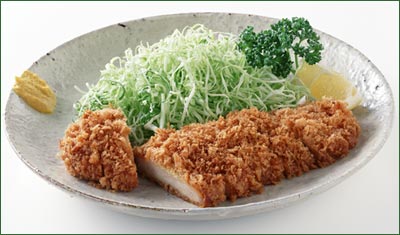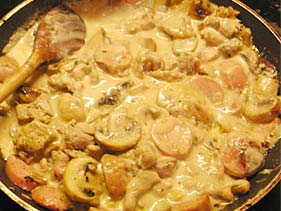
[Update:] A few people found this recipe to be not sweet enough. If you like your lemon bars to be a bit sweeter, try this recipe instead.
It's winter now and not much is in season fruit-wise. Of course we can get any kind of fruit and vegetables year-round now, but a winter strawberry is pretty tasteless. Fortunately, we have citrus fruits, shipped from warmer climates.
Filed under:
dessert snack cookies sweet lemon
There is a great article in the New York Times about bagels, the quintissential New York bread. It made me feel quite nostalgic.
Filed under:
bread baking

tonkatsu, breaded deep fried pork cutlets
Tonkatsu is a typical Japanglish word - ton is pig or pork, and katsu derives from the word cutlet. Tonkatsu is one of the western-style Japanese dishes that can be classified as yohshoku. However, tonkatsu is so popular in Japan that there are even restaurants that only serve tonkatsu and similar items such as kushikatsu (bite-sized fried bits of pork and other things on a skewer).
One of the key ingredients for tonkatsu, or any breaded deep-fried item in Japanese cooking, is panko. In recent years panko has been adopted by the trendy world of cuisine, but it's not anything special - it's just dried bread crumbs. The thing that makes panko unique is that the flakes are bigger and crunchier than the kind sold by non-Japanese food manufacturers.
You can buy panko ready-made at Japanese food stores, or make your own. To make your own, take off the crusts of day-old good white bread. Flake the white part of the bread by hand, not the food processor, which would turn the bread into powder. Spread out the bread crumbs on baking sheets and dry in the oven at a very low temperature until the crumbs are thoroughly try - not colored, just crunchy. You can store this in tightly sealed plastic bags or containers for quite a long time.
Filed under:
japanese yohshoku pork
Happy new year!
Last night, we had two favorites for our little New Year's Eve party - blini with caviar and smoked salmon, with a local speciality called Blauacher Chlöpfmoscht.
Filed under:
party food swiss new year pastry
This is the final chapter of my accounts of making desem bread, which is made with just flour, water, salt and nothing else. It's somewhere between regular baking and a science project.
My desem is now about three weeks old, and is quite mature. How do I know it's mature? Because, after it's been fed some fresh flour and water, it turns quite spongy within a few hours. It also dissolves completely in water, leaving no strings of gluten in my hand.
Filed under:
bread baking desem
Palm Digital Media has been giving away a free ebook a day for the "12 days of Christmas". One of the free books was Little Women, by Louisa May Alcott. I hadn't read it in quite a long time, and it was like visiting an old friend from my childhood to do so now. Its slightly preachy, rather sappy and quite Victorian tone is really perfect for the Christmas season.
Filed under:
preserves and pickles
This is the continuation of my accounts of making desem bread, which is made with just flour, water, salt and nothing else. It's somewhere between regular baking and a science project.
Filed under:
bread baking desem

Filed under:
swiss zurich veal
So, once you have a desem, how do you take care of it?
For the second week (that is the week after it's been born, then grown in the in the incubator flour bed), it has to be fed every day. The thing to keep in mind is that you shouldn't feed it more flour than is already in it.
Filed under:
bread baking desem
This is the continuation of my accounts of making desem bread, which is made with just flour, water, salt and nothing else. It's somewhere between regular baking and a science project.
I am writing this somewhat bleary-eyed after a late night...
The process of making the first loaf of desem bread is very long, and it's easy to miscalculate the time needed. That's what I did. Here's how it went...
Filed under:
bread baking desem
Pages